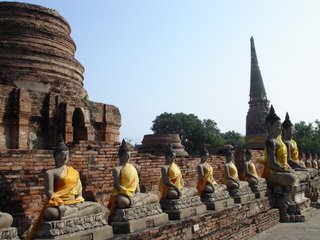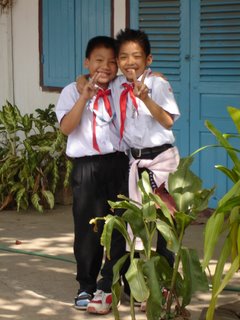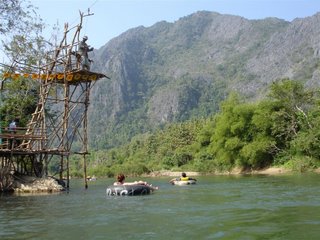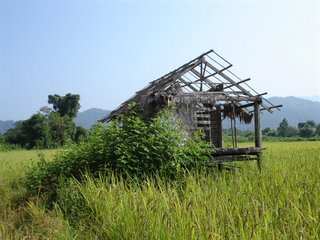The roads infrastracture of Laos is still in poor condition. The only way to reach many remote villages is still by boat. It's pretty expensive, unless several people share the boat. After taking a pick-up truck from Luang Prabang up north to Nong Khiaw, I decided to go to a small village of Muang Ngoi, further north on the river. Travelling against the current was rough, at some point the boat hit the bank on river, and the driver took off his clothes, staying only in underwear and ran back and forth on the boat, bringing tools and fixing the navigation, while the passengers grabbed the branches of a bush on the bank to prevent the boat from flowing away. Seemed it wasn't the first time the driver had to deal with this situation, and after half an hour the boat sailed on its way. The village of Muang Ngoi is completely isolated from the main roads, and the loudest sounds are of boats' motors and roosters' cries at morning. The weather is pleasant, at morning even cold, lots of mist cover the mountains near the banks. The scenery around is very beatiful, Lao farmers in pointed hats working in rice fields, small picturesque villages with traditional wooden houses, surrounded by jungle crossed by streams and caves nearby. Trekking around is very easy, since most of the trails are flat. After staying there for 2 days, I was planning to go further north on the river, but there was no "local boat" scheduled, so next time I guess... Made the same way back south, stopping in Luang Prabang and Vientiane to break the long bus journey, for some Beerlao on the bank of Mekong river. Next place was Savannakhet, a French ghost town, reminding of the capital a little bit, with its shattered colonial buildings, but much more quiet. Not much to do there. The guest house was very nice, with a wooden veranda and a balcony, with 2 old bombs fuses. It's really no problem finding souvenirs like these around. On average, US poured on the head of every Lao citizien more than half a ton of explosives! Next day, Pakse. Around: waterfalls, coffee plantations, and lots of friendly people. After a couple of days there I took a boat down the Mekong to Champasak, a nice village located close to Wat Phu, which is a complex of ancient Khmer ruins. It's probably not as impressive as Angkor Wat in Cambodia, but it's nice, since in Laos there aren't many ancient sights. The complex has 3 levels, connected with steep naga (serpent) stairway, with the national Lao trees providing some shade from the sides. The temples themselves aren't very impressive, but the view from the upper level to the complex downstairs, the pools near the entrance and the villages on the plains is stunning. There's a sacred spring coming from the mountain and a few big boulders with carvings are scattered around. Worth the afternoon.
Moved further south, to an area called Si Phan Don, or 4000 islands. I stayed in a bungalow on Don Det island, watching beatiful sunsets over the Mekong, walking around the rice fields, playing with local children and jumping from the veranda to the Mekong for a nice dip in hot afternoon.
After running out of kip (Lao currency), I decided to cross the border with Cambodia, which is only 20 km south. Crossing is very easy, after putting $1 bill in the passport for the nice Cambodian officials. The closest town to the border is Stung Treng, from where I took a bus east, to Ratanakiri province. The roads in Cambodia, if they're not brand new, are in VERY bad condition, not to mention the red dust which covers the clothes and the skin with a thick layer. Fortunately, respiration masks are sold everywhere, and they're essential for motorbike travelling, so are sunglasses. After arriving to a dusty town called Ban Lung, I explored the surroundings, which include a beatiful crater lake, several waterfalls and ethnic villages, where people still sacrifice animals in case of problems. The Cambodians are very friendly, considering the horrors which they were passing through just until recently. The monks are especially glad to get a foreign visitor, they are eager to practice their English, and are extremely hospitable.
Education is considered very important and it's good to see there are schools in most of the villages. The poverty is much more eye catching though, although there are lots of 4WD navigating the bad roads, most people are definitely very poor.
Saturday, November 25, 2006
Tuesday, November 07, 2006
Luang Prabang
While waiting for my visa to arrive, it was hard to stay in Bangkok. Made one day out, in Ayutaya, former Thai capital, sacked by the Burmese. It's spread over huge territory, with red-brick stupas and temples, statues of Buddha, sitting, reclining.

The place is nice, but very tourist-oriented, probably because it's near Bangkok. I didn't explore Thailand this time, but after a week it felt very commercial.
Immediately after arriving in Laos the atmosphere is different, the life flows in its slow patient way, there's no need to rush things. Vientiane is a sleepy capital, more an urban village. The communism is funny because the mentality of people is not to make noise and be content with the small pleasures. They're very sympathic.

The capital is located on the coast of Mekong river, la promenade is full of food and drink vendors. There are also a lot of temples, although there's communism, and monks everywhere. The biggest city can be explored in one day. About 160 km north - Vieng Vieng, a village near Ham Son river. The main street is just a pack of guest houses combined with TV restaurants, where episodes of "Friends" are running all day long, with pretty much success it seems. The river is very nice, good to swim, cool and clear water. People float along the river, in inflated tractor tubes, it's called 'tubing'. On the way there are jumping towers and small cafes.
Motorbike is possible to rent in the village and good to explore around. Beatiful countryside with banana plantations and rice fields.
On the other side of the river - wicked mountains covered with thick jungle, with caves, some of them are very deep and going a long way, with Buddha statues, stalactits, big underground pools of water, strange fish etc. Very nice. Next place along the Rte 13 up north - Luang Prabang, very charming French colonial town. Lots of temples, beatiful night market with clothes & handicrafts. Morning market also very nice, selling frits & vegetables, live and dead fish and animals, insects, spiders, frogs and snakes. The town is pretty small, but not boring. The French villas, together with traditional Lao wooden houses, create a very enjoyable and unique atmosphere.

The place is nice, but very tourist-oriented, probably because it's near Bangkok. I didn't explore Thailand this time, but after a week it felt very commercial.
Immediately after arriving in Laos the atmosphere is different, the life flows in its slow patient way, there's no need to rush things. Vientiane is a sleepy capital, more an urban village. The communism is funny because the mentality of people is not to make noise and be content with the small pleasures. They're very sympathic.

The capital is located on the coast of Mekong river, la promenade is full of food and drink vendors. There are also a lot of temples, although there's communism, and monks everywhere. The biggest city can be explored in one day. About 160 km north - Vieng Vieng, a village near Ham Son river. The main street is just a pack of guest houses combined with TV restaurants, where episodes of "Friends" are running all day long, with pretty much success it seems. The river is very nice, good to swim, cool and clear water. People float along the river, in inflated tractor tubes, it's called 'tubing'. On the way there are jumping towers and small cafes.

Motorbike is possible to rent in the village and good to explore around. Beatiful countryside with banana plantations and rice fields.

On the other side of the river - wicked mountains covered with thick jungle, with caves, some of them are very deep and going a long way, with Buddha statues, stalactits, big underground pools of water, strange fish etc. Very nice. Next place along the Rte 13 up north - Luang Prabang, very charming French colonial town. Lots of temples, beatiful night market with clothes & handicrafts. Morning market also very nice, selling frits & vegetables, live and dead fish and animals, insects, spiders, frogs and snakes. The town is pretty small, but not boring. The French villas, together with traditional Lao wooden houses, create a very enjoyable and unique atmosphere.
Subscribe to:
Posts (Atom)


